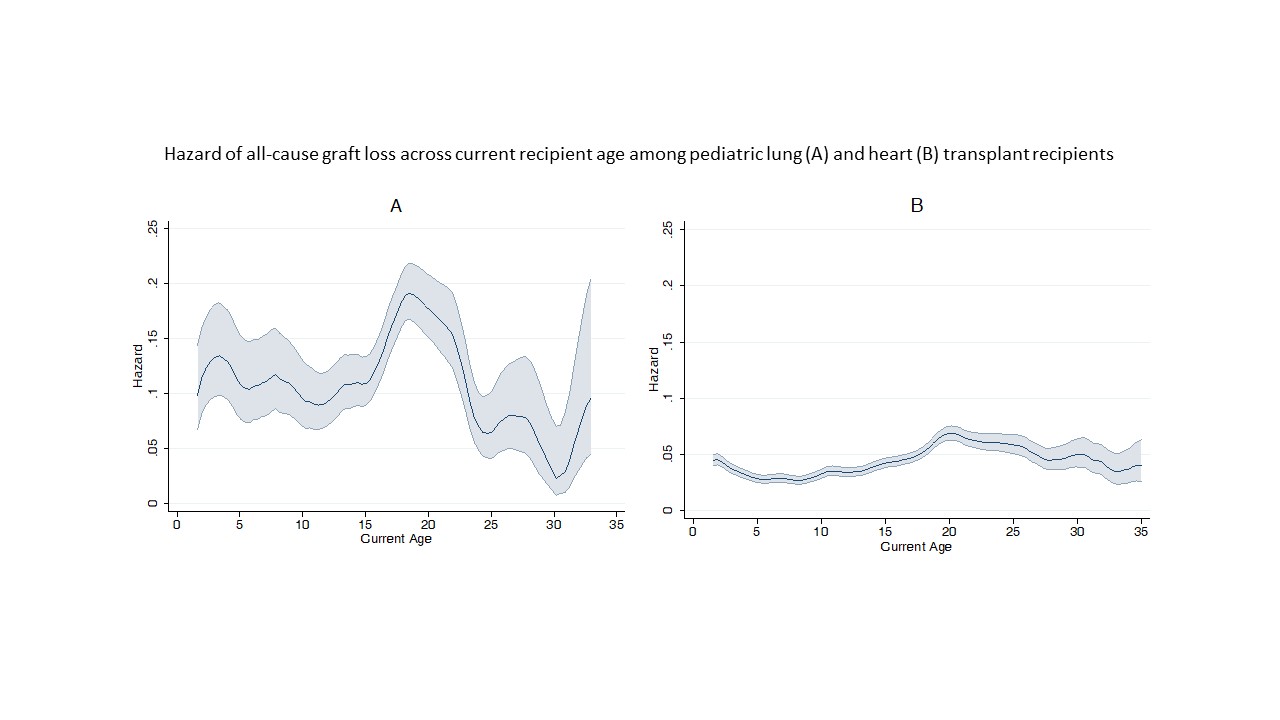Pediatric Heart and Lung Graft Loss during the “High-Risk Age Window”
1Johns Hopkins School of Medicine, Baltimore, MD, 2University Of Alabama at Birmingham, Birmingham, AL, 3Children’s Hospital of Wisconsin-Milwaukee Campus, Milwaukee, WI
Meeting: 2019 American Transplant Congress
Abstract number: C343
Keywords: Graft survival, Heart, Lung, Pediatric
Session Information
Session Name: Poster Session C: Lung: All Topics
Session Type: Poster Session
Date: Monday, June 3, 2019
Session Time: 6:00pm-7:00pm
 Presentation Time: 6:00pm-7:00pm
Presentation Time: 6:00pm-7:00pm
Location: Hall C & D
*Purpose: Pediatric kidney transplant recipients experience a high-risk age window of increased graft loss during late adolescence and early adulthood (17-24 years), termed emerging adulthood. Previously, this high-risk age window had been attributed to primarily sociobehavioral factors such as nonadherence. Since pediatric heart and lung transplant recipients undergo a similar transition, we examined if they were also at increased risk for graft-loss during emerging adulthood.
*Methods: Using registry data from SRTR from 1987 to 2018, we estimated all-cause graft loss at current recipient age among 1198 lung and 7997 heart pediatric transplant recipients using piecewise-constant hazard rate regressions. In both models, we adjusted for year of transplant as well as donor and recipient characteristics. Combined heart-lung transplant recipients were excluded.
*Results: Pediatric lung transplant recipients were more likely to experience graft loss between 17-24 years of age compared to those <17 (aHR=1.14 1.34 1.58, p<0.001) and >24 (aHR=2.03 2.87 4.06, p<0.001) (Figure, A). However, among heart transplant recipients, the high-risk age window for graft was between 0-3 years of age, compared to ages 3-17 (aHR= 0.48 0.55 0.63, p<0.001), 17-24 (aHR=0.67 0.78 0.92, p=0.003), and >24 (aHR=0.45 0.55 0.67, p<0.001) (Figure, B).
*Conclusions: Emerging adulthood is a high-risk period for pediatric lung transplant recipients, but it is not characterized by an increased risk of graft loss for pediatric heart transplant recipients. These findings suggest that sociobehavioral factors alone do not fully account for the high-risk age window and that other biologic etiologies should be considered.
To cite this abstract in AMA style:
Long J, Motter J, Jackson KR, Kosztowski M, Orandi B, Luo X, Arendonk KVan, Massie A, Bush E, Higgins RS, Segev DL, Garonzik-Wang JM. Pediatric Heart and Lung Graft Loss during the “High-Risk Age Window” [abstract]. Am J Transplant. 2019; 19 (suppl 3). https://atcmeetingabstracts.com/abstract/pediatric-heart-and-lung-graft-loss-during-the-high-risk-age-window/. Accessed July 13, 2025.« Back to 2019 American Transplant Congress

